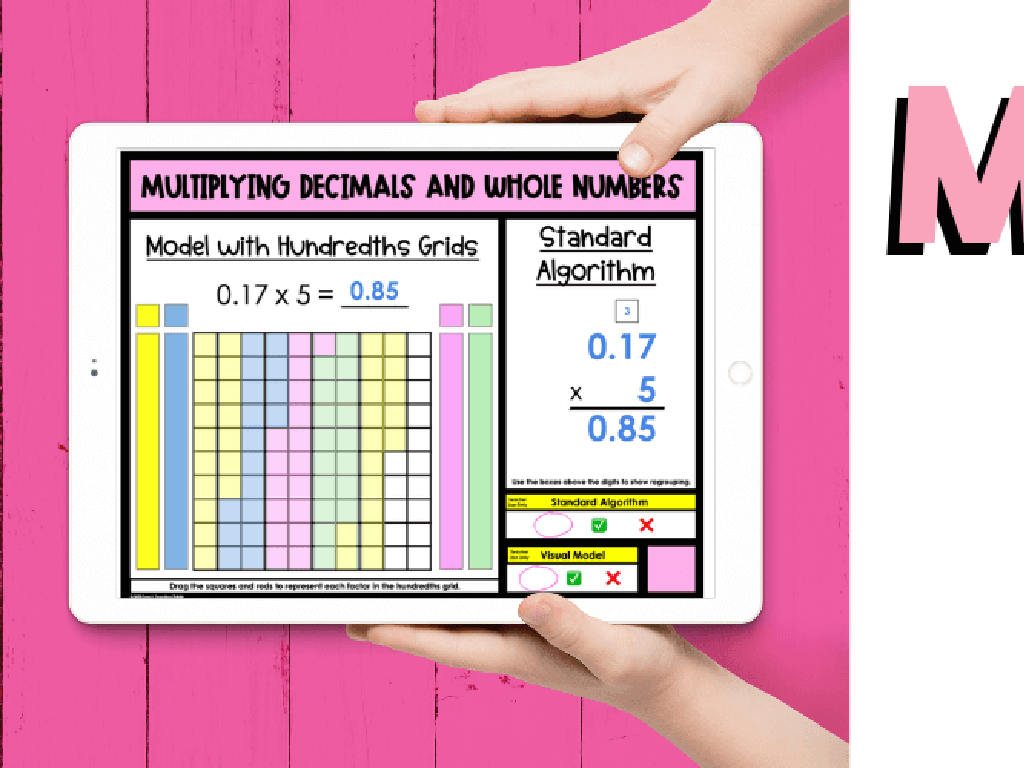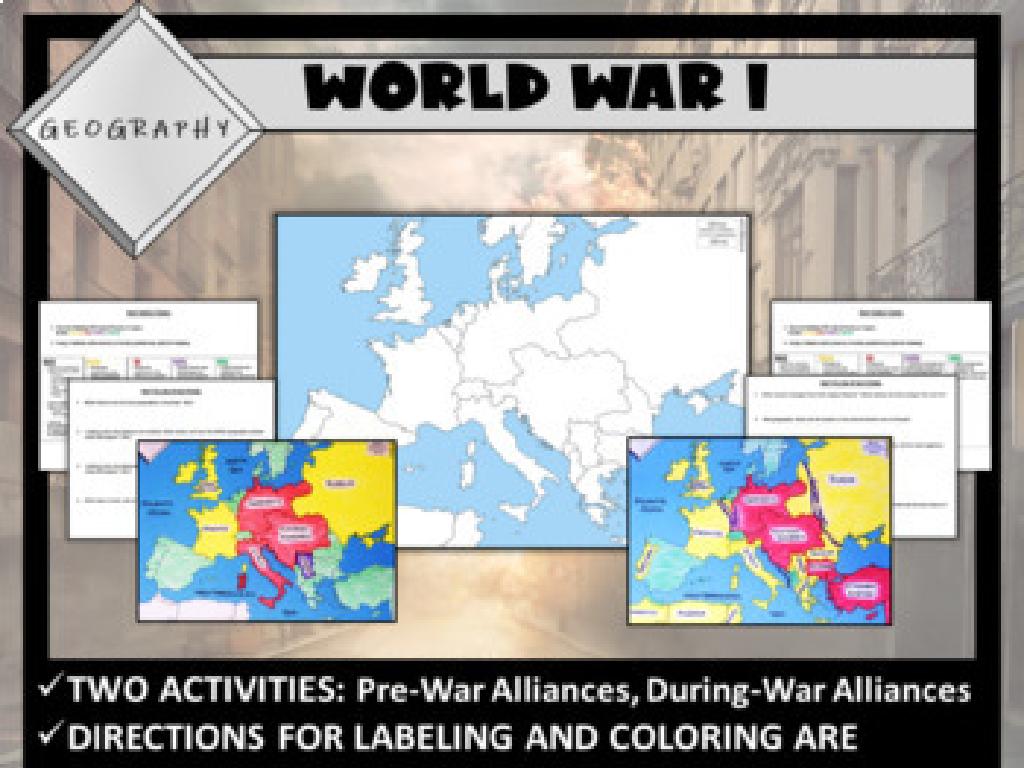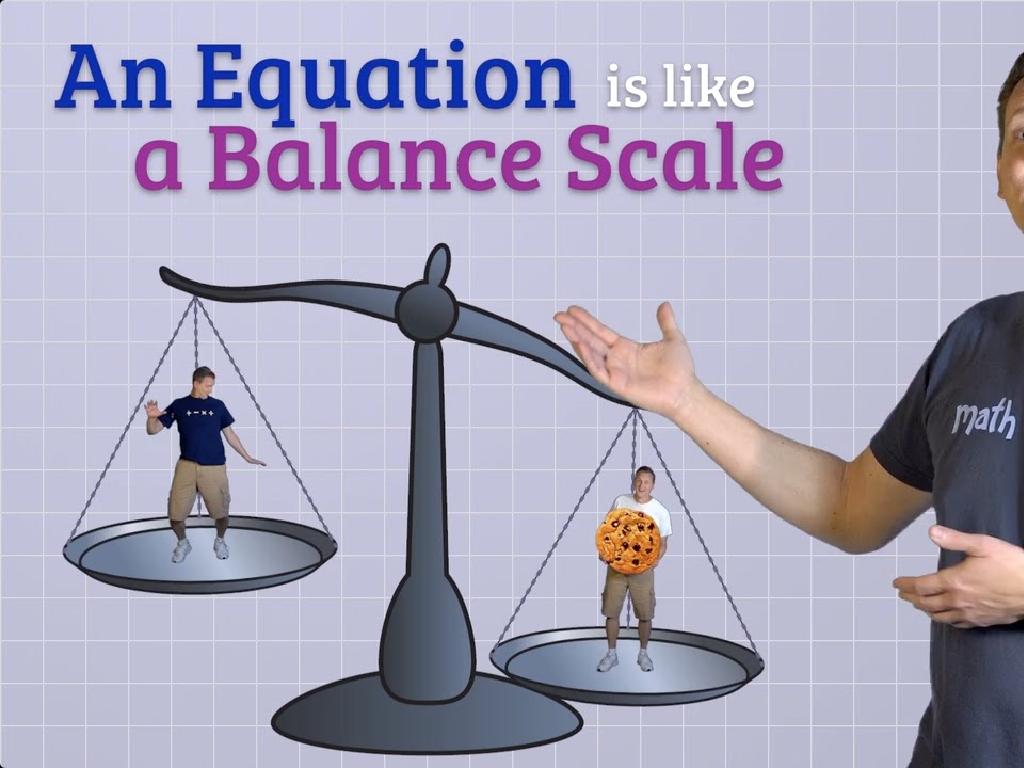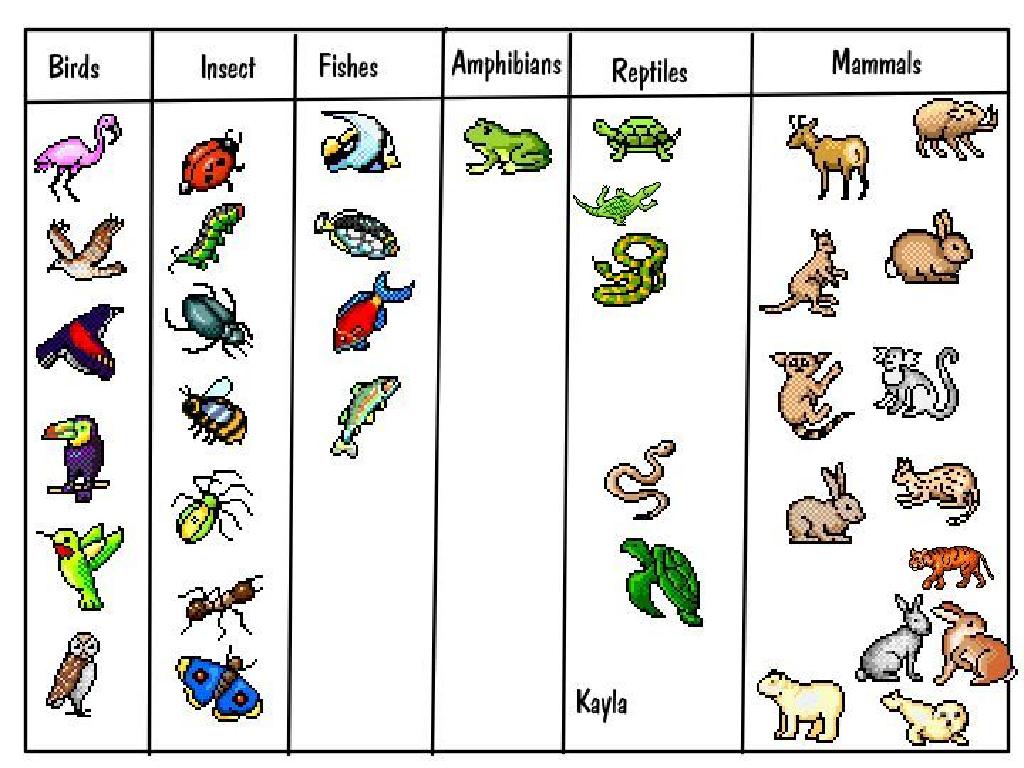Identify A Half, A Third, And A Fourth
Subject: Math
Grade: Second grade
Topic: Fractions
Please LOG IN to download the presentation. Access is available to registered users only.
View More Content
Welcome to Fractions!
– Learning about parts of a whole
– What are halves, thirds, and fourths?
– A half is when you divide something into 2 equal parts. A third is 1 of 3 equal parts, and a fourth is 1 of 4.
– The role of fractions in everyday life
– Fractions help us in cooking, sharing, and understanding sizes.
– Practice makes perfect with fractions
|
This slide introduces the concept of fractions to second graders, focusing on halves, thirds, and fourths. Begin by explaining that a fraction represents a part of a whole, using tangible examples like cutting an apple or pizza. Emphasize the importance of equal parts for it to be a fraction. Discuss real-life applications of fractions, such as dividing a pizza among friends or measuring ingredients in a recipe. Encourage students to think of examples where they have encountered fractions. Plan activities where students can practice by dividing shapes or objects into halves, thirds, and fourths to reinforce the concept.
Understanding Fractions
– A fraction is part of a whole
– Imagine breaking a cookie
– Like splitting it into 4 pieces
– Each piece is a fraction
– One piece is 1/4 of the cookie
– Fractions in everyday life
– Pizza slices, water jugs, etc.
|
Introduce the concept of fractions to the students by comparing it to dividing something familiar, like a cookie, into smaller parts. Explain that each part is a fraction of the whole cookie. Use real-life examples such as slices of pizza or portions of a water jug to illustrate fractions in a way that is relatable to second graders. Emphasize that fractions are everywhere around us and are a way of representing parts of a whole. Encourage students to think of other examples where they encounter fractions in their daily lives.
Identifying Halves in Fractions
– Understanding ‘a half’
– A half means one of two equal parts of a whole
– Cutting things into halves
– When you divide something evenly into 2 pieces, each is a half
– Example: Half of an apple
– If you cut an apple into 2 equal parts, each part is a half
|
This slide introduces the concept of halves to second-grade students. Begin by explaining that a half is one of two equal parts of a whole item. Use visual aids, like a picture of an apple, to show how it can be cut into two equal pieces, with each piece representing a half. Emphasize that both pieces must be the same size to be considered halves. Encourage students to think of other items that can be divided into halves and to practice this concept with real objects. This tangible approach helps solidify their understanding of fractions as parts of a whole.
Identifying Thirds in Fractions
– What does a third mean?
– A third is 1 out of 3 equal parts of a whole
– Cutting things into thirds
– Imagine dividing an object into 3 equal sections
– Each piece is a third
– Every section represents a third (1/3)
– Example: Third of a sandwich
– If you split a sandwich into 3 equal parts, each is 1/3
|
This slide introduces the concept of ‘thirds’ in fractions, tailored for second-grade students. Begin by explaining that a third means one part of something that has been divided into three equal parts. Use visual aids, like a drawing of a circle or a sandwich, to show how an item can be cut into three pieces. Emphasize that each piece is called a third and represents one part of the whole. Provide an example, such as dividing a sandwich into three equal parts, where each part is one third of the sandwich. Encourage students to think of other items that can be divided into thirds to reinforce the concept.
Identifying Fourths in Fractions
– What does a fourth mean?
– A fourth is one out of four equal parts of a whole
– Cutting things into four pieces
– Imagine dividing an object into 4 same-size sections
– Each piece is a fourth
– One of those sections is called a fourth
– Example: A pizza cut into fourths
– If you slice a pizza into 4 equal parts, each slice is one fourth
|
This slide introduces the concept of fourths to second-grade students. Begin by explaining that a fourth is one of four equal parts of something. Use tangible examples like cutting a pizza or a sandwich into four equal pieces to illustrate the point. Show them that each piece represents a fourth and that it is written as 1/4. Encourage students to think of other items that can be divided into fourths and share their ideas. Use visuals if possible to help them understand the concept of equal parts. This foundational understanding of fractions will be crucial for their future math skills.
Let’s Practice Fractions Together!
– Identify fractions with objects
– Look at objects and decide what fraction they represent
– Cut shapes into halves, thirds, fourths
– Use scissors to practice making equal parts of paper shapes
– Group activity: Classroom fractions
– Work with classmates to find items that can be divided into fractions
– Discuss our findings as a class
|
This interactive slide is designed for a hands-on class activity to help second graders understand fractions by visualizing and physically manipulating objects. Start by showing different objects and asking students to identify if they can be represented as a half, a third, or a fourth. Then, move on to a cutting activity where students use scissors to divide paper shapes into equal parts, reinforcing the concept of halves, thirds, and fourths. For the group activity, students will search the classroom for items that can be divided into fractions, such as a set of pencils or a pizza into slices. Conclude the activity by discussing as a class what they found and how they determined the fractions. This will help students to apply the concept of fractions to real-world scenarios and enhance their understanding through peer learning.
Fraction Fun Activity: Pizza Party!
– Create a paper pizza
– Divide pizza into fractions
– Cut your pizza into 2, 3, or 4 equal slices
– Identify halves, thirds, and fourths
– Label each slice with the correct fraction
– Share your pizza with the class
|
This class activity is designed to help students understand fractions in a fun and interactive way. Provide each student with a circle of paper to represent a pizza. Guide them to fold and cut the paper into equal parts to create halves, thirds, and fourths. Encourage them to label each slice with the corresponding fraction. Once completed, students will share their paper pizzas with the class, explaining how they divided their pizza and identified each fraction. This hands-on activity not only reinforces the concept of fractions but also promotes sharing and discussion among students. Possible variations of the activity could include using different colored paper for various toppings, creating a pizza fraction wall display, or even using real pizza for a tasty math lesson.
Fraction Review: Halves, Thirds, and Fourths
– Recap on fractions learned
– Examples of halves, thirds, fourths
– A half: 1/2 of a pizza, A third: 1/3 of a pie, A fourth: 1/4 of a cake
– Engage with Q&A session
– Reinforce fraction concepts
|
This slide is aimed at reviewing the day’s lesson on fractions. Start by asking the class what they remember about fractions, specifically halves, thirds, and fourths. Encourage students to provide examples of each fraction type, possibly using items in the classroom or from their experiences, like sharing food. Proceed to a Q&A session where students can ask questions and get clarifications on the day’s lesson. Use this opportunity to assess understanding and reinforce the concepts of fractions with real-life examples. Make sure to acknowledge correct answers and provide guidance where there are misconceptions.
Homework Challenge: Exploring Fractions
– Find examples of halves at home
– Discover and draw thirds
– Look for fourths and sketch them
– Share your drawings in class
|
This homework activity is designed to help students identify and understand fractions in a practical and engaging way. By finding real-life examples of halves, thirds, and fourths, students will be able to visualize these fractions outside of the classroom. Encourage them to be creative and look for items that can be divided into equal parts, such as fruits for halves, pizza slices for thirds, or a chocolate bar for fourths. Remind them to draw what they find and be ready to present their examples to the class. This will not only reinforce their understanding of fractions but also enhance their communication skills. For the teacher: Prepare to facilitate the sharing session, ensuring each student has a chance to explain their drawings and what fraction they represent. This will also be an opportunity to assess their comprehension of the concept.






